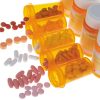- Empty cart.
- Continue Shopping
How to Use Inhalers Correctly

Inhalers are essential medical devices used to deliver medication directly to the lungs, making them a primary treatment option for respiratory conditions like asthma and chronic obstructive pulmonary disease (COPD). Proper inhaler technique is crucial to ensure that the medication reaches the lungs effectively.
Types of Inhalers
There are various types of inhalers, each with its specific instructions for use. The most common types include:
- Metered-Dose Inhalers (MDIs): These inhalers deliver a pre-measured dose of medication with each actuation.
- Dry Powder Inhalers (DPIs): DPIs release medication in the form of dry powder, which requires a deep and fast inhalation.
- Soft Mist Inhalers (SMIs): SMIs produce a slow-moving, soft mist of medication that is inhaled more slowly than MDIs.
- Nebulizers: Nebulizers are machines that convert liquid medication into a fine mist for inhalation.
Step-by-Step Guide to Using Inhalers
1. Read the Instructions
Before using your inhaler, carefully read the instructions provided by your healthcare provider or on the medication label. It’s essential to understand the specific steps for your type of inhaler.
2. Prepare the Inhaler
a. Shake the Inhaler: Some inhalers, like MDIs, need to be shaken before use. Check the instructions to determine if this applies to your inhaler.
b. Prime the Inhaler: If your inhaler is new or hasn’t been used for a while, it may need to be primed. Priming ensures that the first dose is full and effective. Follow the instructions for priming if required.
3. Breathe Out
a. Exhale Completely: Before using the inhaler, exhale completely to get rid of as much air from your lungs as possible.
4. Use the Inhaler
a. Position the Inhaler: Hold the inhaler in an upright, vertical position with the mouthpiece at the bottom and the cap on top.
b. Seal Your Lips: Place the mouthpiece between your teeth and seal your lips tightly around it, ensuring that your tongue does not block the opening.
c. Inhale Slowly and Deeply: Start inhaling slowly and deeply through your mouth as soon as you press down on the inhaler’s canister (for MDIs) or activate the inhaler (for DPIs or SMIs). The goal is to inhale the medication into your lungs, not just your throat.
d. Timing is Key: Coordination between actuating the inhaler and inhaling is essential. Follow the specific timing instructions for your inhaler type.
5. Hold Your Breath
After inhaling the medication, hold your breath for 10 seconds or as long as comfortably possible. This allows the medication to reach deep into your lungs.
6. Exhale Slowly
Exhale slowly and gently, ensuring that you don’t forcefully blow out any remaining medication in your lungs.
7. Rinse Your Mouth (if necessary)
Some medications, especially corticosteroids, may increase the risk of oral thrush. Rinse your mouth with water and spit it out after using these inhalers to minimize this risk.
8. Clean the Inhaler
Regularly clean your inhaler according to the manufacturer’s instructions to prevent clogs and ensure proper function.
Additional Tips
- Keep a record of your inhaler use to monitor adherence and discuss it with your healthcare provider during check-ups.
- If you’re using multiple inhalers, know the correct order to use them, as different types of inhalers may require specific sequences.
- Always carry a spare inhaler in case your primary one runs out or malfunctions.
- If you have any difficulty using your inhaler, or if you’re unsure if you’re using it correctly, consult your healthcare provider or a pharmacist for guidance.
In Conclusion, Proper inhaler technique is essential to ensure that you receive the full benefit of your medication for managing respiratory conditions like asthma or COPD. By following the specific instructions for your type of inhaler, you can effectively deliver the medication to your lungs, leading to improved symptom control and a better quality of life. Remember to consult your healthcare provider or pharmacist if you have any questions or concerns about your inhaler use.








